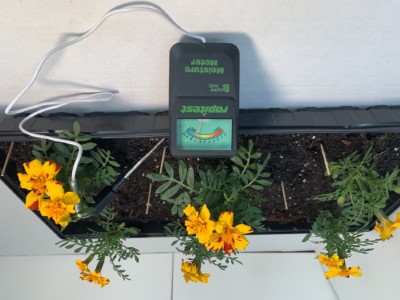Earth Science Week Classroom Activities
Maintaining Soil Moisture
Activity Source:
American Geophysical Union. Adapted with permission.
Soil is a vital component of almost every ecosystem, and its health often determines the viability of the whole ecosystem. If a soil cannot support the living organisms within it – such as insects, bacteria, fungi, and plant roots – then it is likely that the entire ecosystem will suffer. The same is true on farms. The success of crops is dependent on the health of the soil.
One component of soil health is its ability to maintain moisture, which is needed not only by plants, but by all the organisms within the soil. Common farming practices include tilling and the use of mulch or fertilizer. Each of these practices influences soil moisture. Sustainable farming practices have been developed to help maintain soil health. In this activity, you will test ways to help maintain soil moisture and relate it to sustainable farming practices.
Materials
- Germination tray (approximately 21” long and 2-4" deep)
- Soil (preferably collected from your area)
- 4-6 small plants
- Watering can
- Soil moisture meter
- Small dowels
- Lamp (optional)
- Materials specific to your design

Credit: L. Mossa, AGI
Procedure
- Evenly space your small plants in the germination tray. If the root bulb is too tall for the tray, you may need to break up the root bulb a bit.
- Fill the area around the plants with soil. Be sure the soil is an even depth throughout the tray. Avoid packing down the soil.
- Use a spray bottle to water the plants. Insert the soil moisture meter at three to five spots to test that the soil is evenly and well watered throughout the tray. Be sure to test some spots under the plants, as well as in the middle of the tray. Place a dowel at each test spot, so you can consistently test the same areas.
- Place the tray in an area where the plants will get enough sun or under a lamp. Test the soil moisture every 24 hours for three days. Record your data.
- On the third day, add enough water to get the soil back to its original moisture content.
- Research common farming practices and plan out how you can demonstrate this practice on the tray. For example, to test tilling, you could use a gardening fork to mix the soil between the plants each day.
- Place the tray in the same area as in step 4. Test the soil moisture every 24 hours for three days. Record your data.
- Discuss: Did the farming practice you tested help maintain soil moisture, or did the soil dry out faster? Why do you think this is? Is the practice you tested considered sustainable or traditional? How does your data support this? Research other components of soil health. How are they measured? Test out the farming practice you chose to see if it affects these other soil health components.
NGSS Connections
- SEP: Obtaining, Evaluating, and Communicating Information; Asking Questions and Defining Problems
- DCI: Earth’s Materials and Systems; Human Impacts on Earth’s Systems
- CC: Cause and Effect; Influence of Science, Engineering, and Technology on Society and the Natural World
SDG Connections
- 2: Zero Hunger
- 15: Life on Land
